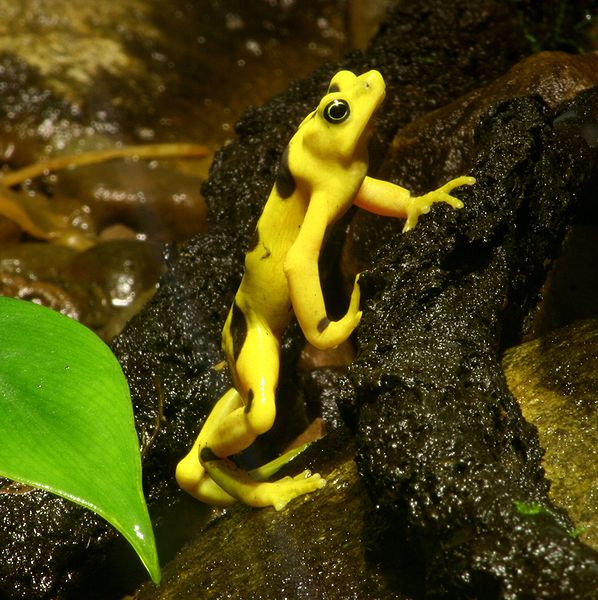Please see Part I of this article to learn about the natural history of the Panamanian Golden Frog , Atelopus zeteki, including it’s unique mode of communication.
Status of Wild Populations
Panamanian Golden Frog numbers are plummeting, most likely due to an epidemic of the largely incurable fungal infection

Chitridiomycosis. The fungus responsible, Batrachochytrium dendrobatidis, has been implicated in the declines and extinctions of numerous amphibian species worldwide. This frog is also threatened by deforestation, stream siltation, pollution and collection for use as a promotional tool in Panama’s restaurant, hotel and tourism industries (this practice is illegal, but enforcement is often lax).
It is estimated that Golden Frog populations have declined by 80% in both numbers and extent of occurrence over a 10 year period. At least 2 distinct populations are extinct, with 1 such extinction occurring within the span of several months. Golden Frogs are designated as “Critically Endangered” by the IUCN and listed on Appendix I of CITES. They are legally protected by Panama and the subject of a cooperative rescue program, administered by the USA and the Republic of Panama, known as “Project Golden Frog”. Fortunately, the Golden Frog breeds well in captivity.
Unique Skin Toxins
This frog’s skin contains extremely virulent nerve toxins that differ from those produced by other amphibians. Known as “zetekitoxins”, the poison contained in the skin of a single 2-inch-long frog is sufficient to kill 1,200 mice! It is believed that these toxins are produced in association with symbiotic bacteria, but this has not yet been definitively documented.
Cultural Significance
The Panamanian Golden Frog is the national animal of the Republic of Panama, and has traditionally been associated with matters relating to good fortune. Pre-Columbian indigenous people molded its likeness in gold and clay talismans known as “huaces”.
Further Reading
You can learn more about Project Golden Frog by clicking here.
 That Reptile Blog – Reptile, Amphibian and Exotic Pet Care and Information
That Reptile Blog – Reptile, Amphibian and Exotic Pet Care and Information

 Golden frogs reach a mere 1.4 – 2.5 inches in length, with individuals inhabiting dry forests being 2/3 the size of wet forest dwellers (please see “Habitat”, below).
Golden frogs reach a mere 1.4 – 2.5 inches in length, with individuals inhabiting dry forests being 2/3 the size of wet forest dwellers (please see “Habitat”, below).